Corporate Governance Analysis: Arcelor Mittal Case Study
VerifiedAdded on 2022/11/28
|10
|2482
|310
Case Study
AI Summary
This case study analyzes the corporate governance structure of Arcelor Mittal, focusing on the post-merger integration of Arcelor and Mittal Steel. The analysis examines the composition and function of the board, highlighting the shift from a family-dominated structure to one with greater representation of independent directors, employee representatives, and nominee directors. It explores the influence of institutional investors, particularly in light of the Mittal family's retained voting rights, and assesses the positive and negative aspects of the pre- and post-merger scenarios. The study evaluates the impact of these changes on decision-making processes, corporate governance, and stakeholder interests, considering issues of trust, authenticity, and flexibility within the organization. The case study draws upon the Financial Times article 'Governance may impede Mittal’s pursuit of Arcelor' to provide context and support for its conclusions.
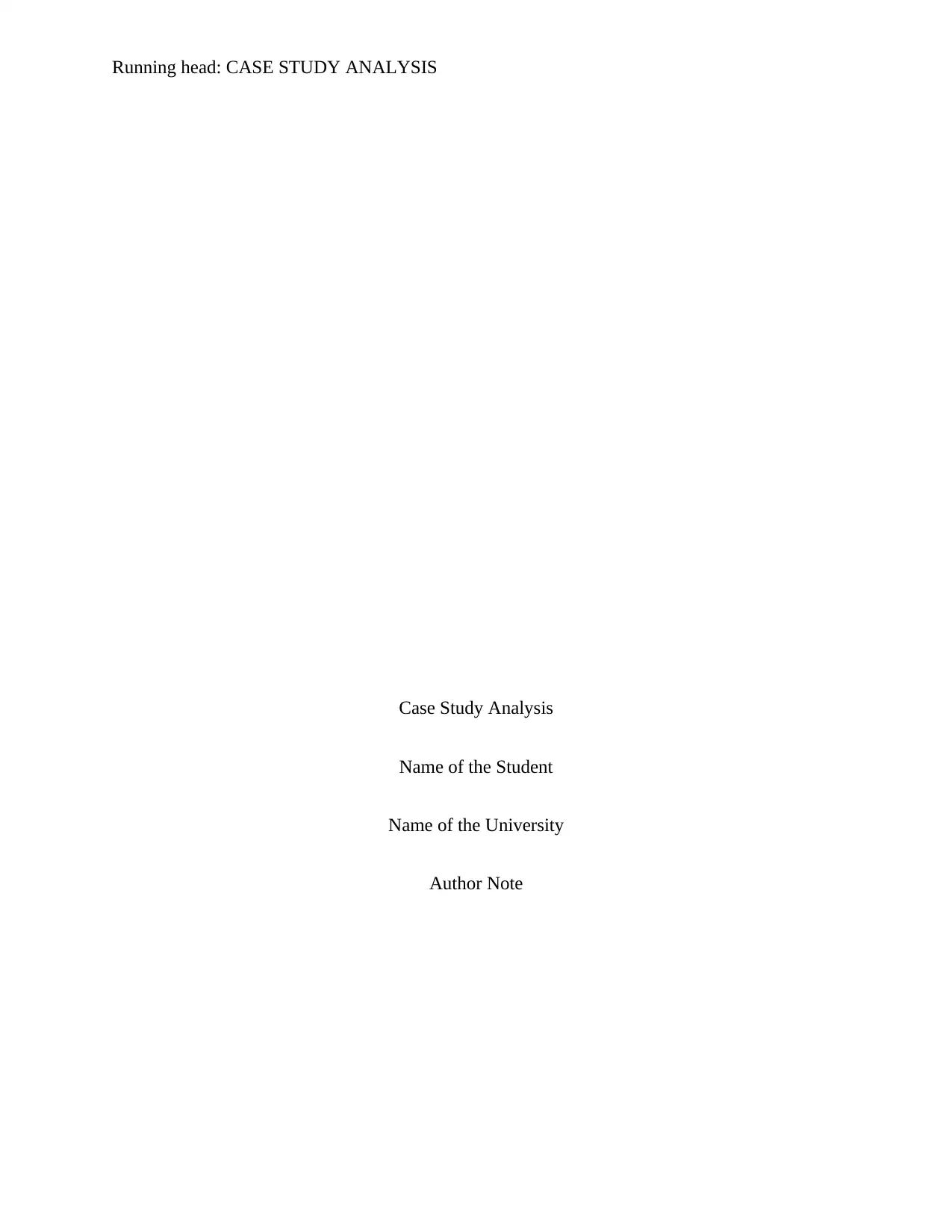
Running head: CASE STUDY ANALYSIS
Case Study Analysis
Name of the Student
Name of the University
Author Note
Case Study Analysis
Name of the Student
Name of the University
Author Note
Paraphrase This Document
Need a fresh take? Get an instant paraphrase of this document with our AI Paraphraser
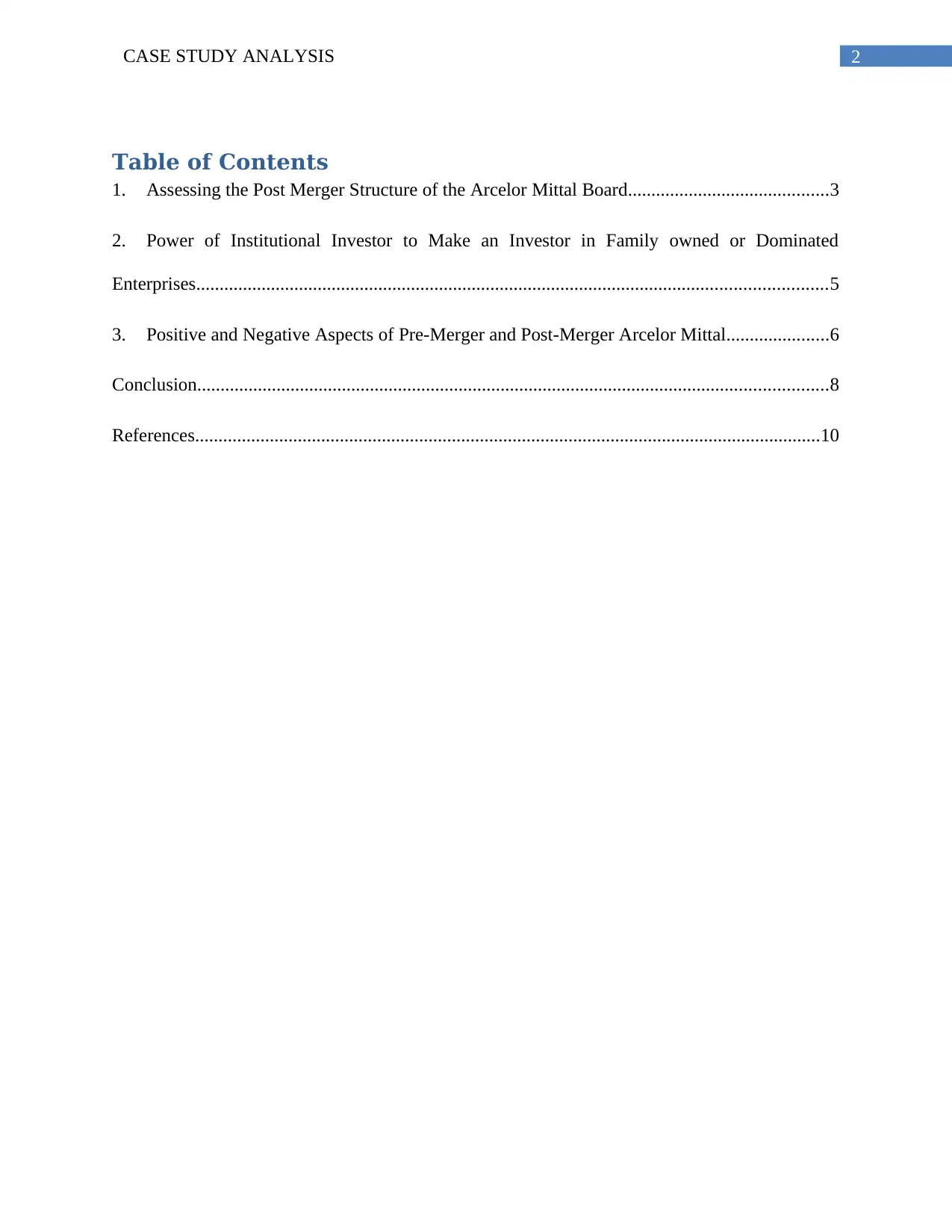
2CASE STUDY ANALYSIS
Table of Contents
1. Assessing the Post Merger Structure of the Arcelor Mittal Board...........................................3
2. Power of Institutional Investor to Make an Investor in Family owned or Dominated
Enterprises.......................................................................................................................................5
3. Positive and Negative Aspects of Pre-Merger and Post-Merger Arcelor Mittal......................6
Conclusion.......................................................................................................................................8
References......................................................................................................................................10
Table of Contents
1. Assessing the Post Merger Structure of the Arcelor Mittal Board...........................................3
2. Power of Institutional Investor to Make an Investor in Family owned or Dominated
Enterprises.......................................................................................................................................5
3. Positive and Negative Aspects of Pre-Merger and Post-Merger Arcelor Mittal......................6
Conclusion.......................................................................................................................................8
References......................................................................................................................................10
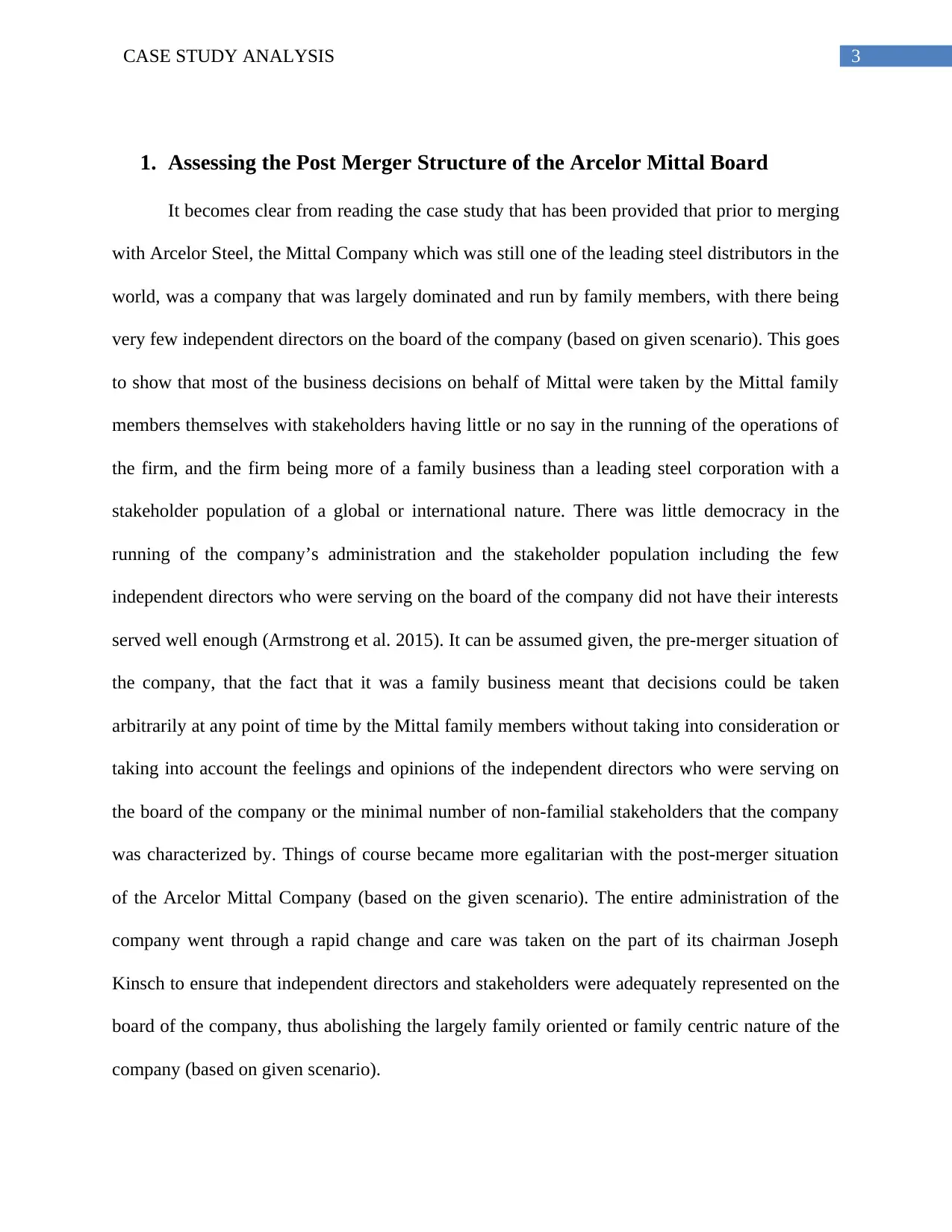
3CASE STUDY ANALYSIS
1. Assessing the Post Merger Structure of the Arcelor Mittal Board
It becomes clear from reading the case study that has been provided that prior to merging
with Arcelor Steel, the Mittal Company which was still one of the leading steel distributors in the
world, was a company that was largely dominated and run by family members, with there being
very few independent directors on the board of the company (based on given scenario). This goes
to show that most of the business decisions on behalf of Mittal were taken by the Mittal family
members themselves with stakeholders having little or no say in the running of the operations of
the firm, and the firm being more of a family business than a leading steel corporation with a
stakeholder population of a global or international nature. There was little democracy in the
running of the company’s administration and the stakeholder population including the few
independent directors who were serving on the board of the company did not have their interests
served well enough (Armstrong et al. 2015). It can be assumed given, the pre-merger situation of
the company, that the fact that it was a family business meant that decisions could be taken
arbitrarily at any point of time by the Mittal family members without taking into consideration or
taking into account the feelings and opinions of the independent directors who were serving on
the board of the company or the minimal number of non-familial stakeholders that the company
was characterized by. Things of course became more egalitarian with the post-merger situation
of the Arcelor Mittal Company (based on the given scenario). The entire administration of the
company went through a rapid change and care was taken on the part of its chairman Joseph
Kinsch to ensure that independent directors and stakeholders were adequately represented on the
board of the company, thus abolishing the largely family oriented or family centric nature of the
company (based on given scenario).
1. Assessing the Post Merger Structure of the Arcelor Mittal Board
It becomes clear from reading the case study that has been provided that prior to merging
with Arcelor Steel, the Mittal Company which was still one of the leading steel distributors in the
world, was a company that was largely dominated and run by family members, with there being
very few independent directors on the board of the company (based on given scenario). This goes
to show that most of the business decisions on behalf of Mittal were taken by the Mittal family
members themselves with stakeholders having little or no say in the running of the operations of
the firm, and the firm being more of a family business than a leading steel corporation with a
stakeholder population of a global or international nature. There was little democracy in the
running of the company’s administration and the stakeholder population including the few
independent directors who were serving on the board of the company did not have their interests
served well enough (Armstrong et al. 2015). It can be assumed given, the pre-merger situation of
the company, that the fact that it was a family business meant that decisions could be taken
arbitrarily at any point of time by the Mittal family members without taking into consideration or
taking into account the feelings and opinions of the independent directors who were serving on
the board of the company or the minimal number of non-familial stakeholders that the company
was characterized by. Things of course became more egalitarian with the post-merger situation
of the Arcelor Mittal Company (based on the given scenario). The entire administration of the
company went through a rapid change and care was taken on the part of its chairman Joseph
Kinsch to ensure that independent directors and stakeholders were adequately represented on the
board of the company, thus abolishing the largely family oriented or family centric nature of the
company (based on given scenario).
⊘ This is a preview!⊘
Do you want full access?
Subscribe today to unlock all pages.

Trusted by 1+ million students worldwide
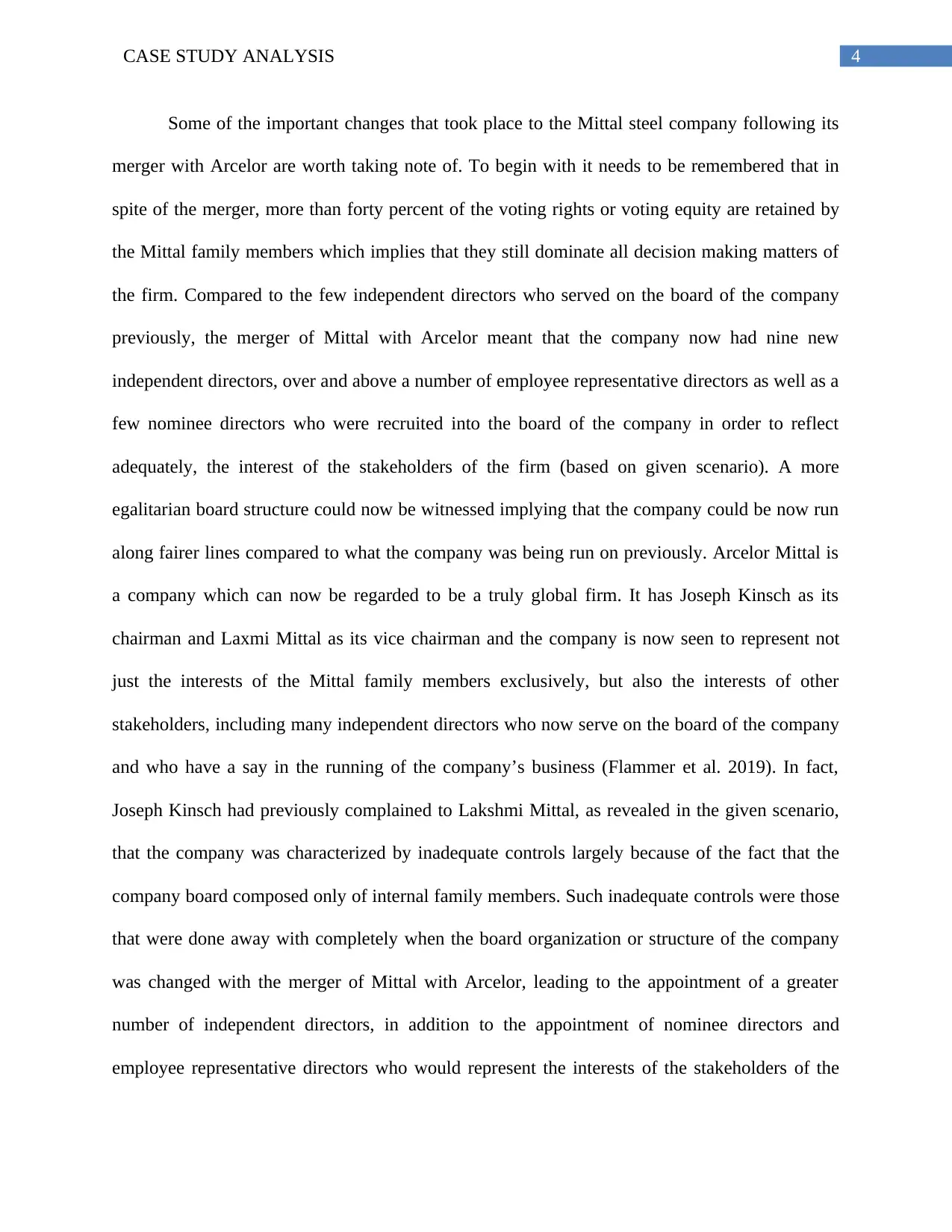
4CASE STUDY ANALYSIS
Some of the important changes that took place to the Mittal steel company following its
merger with Arcelor are worth taking note of. To begin with it needs to be remembered that in
spite of the merger, more than forty percent of the voting rights or voting equity are retained by
the Mittal family members which implies that they still dominate all decision making matters of
the firm. Compared to the few independent directors who served on the board of the company
previously, the merger of Mittal with Arcelor meant that the company now had nine new
independent directors, over and above a number of employee representative directors as well as a
few nominee directors who were recruited into the board of the company in order to reflect
adequately, the interest of the stakeholders of the firm (based on given scenario). A more
egalitarian board structure could now be witnessed implying that the company could be now run
along fairer lines compared to what the company was being run on previously. Arcelor Mittal is
a company which can now be regarded to be a truly global firm. It has Joseph Kinsch as its
chairman and Laxmi Mittal as its vice chairman and the company is now seen to represent not
just the interests of the Mittal family members exclusively, but also the interests of other
stakeholders, including many independent directors who now serve on the board of the company
and who have a say in the running of the company’s business (Flammer et al. 2019). In fact,
Joseph Kinsch had previously complained to Lakshmi Mittal, as revealed in the given scenario,
that the company was characterized by inadequate controls largely because of the fact that the
company board composed only of internal family members. Such inadequate controls were those
that were done away with completely when the board organization or structure of the company
was changed with the merger of Mittal with Arcelor, leading to the appointment of a greater
number of independent directors, in addition to the appointment of nominee directors and
employee representative directors who would represent the interests of the stakeholders of the
Some of the important changes that took place to the Mittal steel company following its
merger with Arcelor are worth taking note of. To begin with it needs to be remembered that in
spite of the merger, more than forty percent of the voting rights or voting equity are retained by
the Mittal family members which implies that they still dominate all decision making matters of
the firm. Compared to the few independent directors who served on the board of the company
previously, the merger of Mittal with Arcelor meant that the company now had nine new
independent directors, over and above a number of employee representative directors as well as a
few nominee directors who were recruited into the board of the company in order to reflect
adequately, the interest of the stakeholders of the firm (based on given scenario). A more
egalitarian board structure could now be witnessed implying that the company could be now run
along fairer lines compared to what the company was being run on previously. Arcelor Mittal is
a company which can now be regarded to be a truly global firm. It has Joseph Kinsch as its
chairman and Laxmi Mittal as its vice chairman and the company is now seen to represent not
just the interests of the Mittal family members exclusively, but also the interests of other
stakeholders, including many independent directors who now serve on the board of the company
and who have a say in the running of the company’s business (Flammer et al. 2019). In fact,
Joseph Kinsch had previously complained to Lakshmi Mittal, as revealed in the given scenario,
that the company was characterized by inadequate controls largely because of the fact that the
company board composed only of internal family members. Such inadequate controls were those
that were done away with completely when the board organization or structure of the company
was changed with the merger of Mittal with Arcelor, leading to the appointment of a greater
number of independent directors, in addition to the appointment of nominee directors and
employee representative directors who would represent the interests of the stakeholders of the
Paraphrase This Document
Need a fresh take? Get an instant paraphrase of this document with our AI Paraphraser
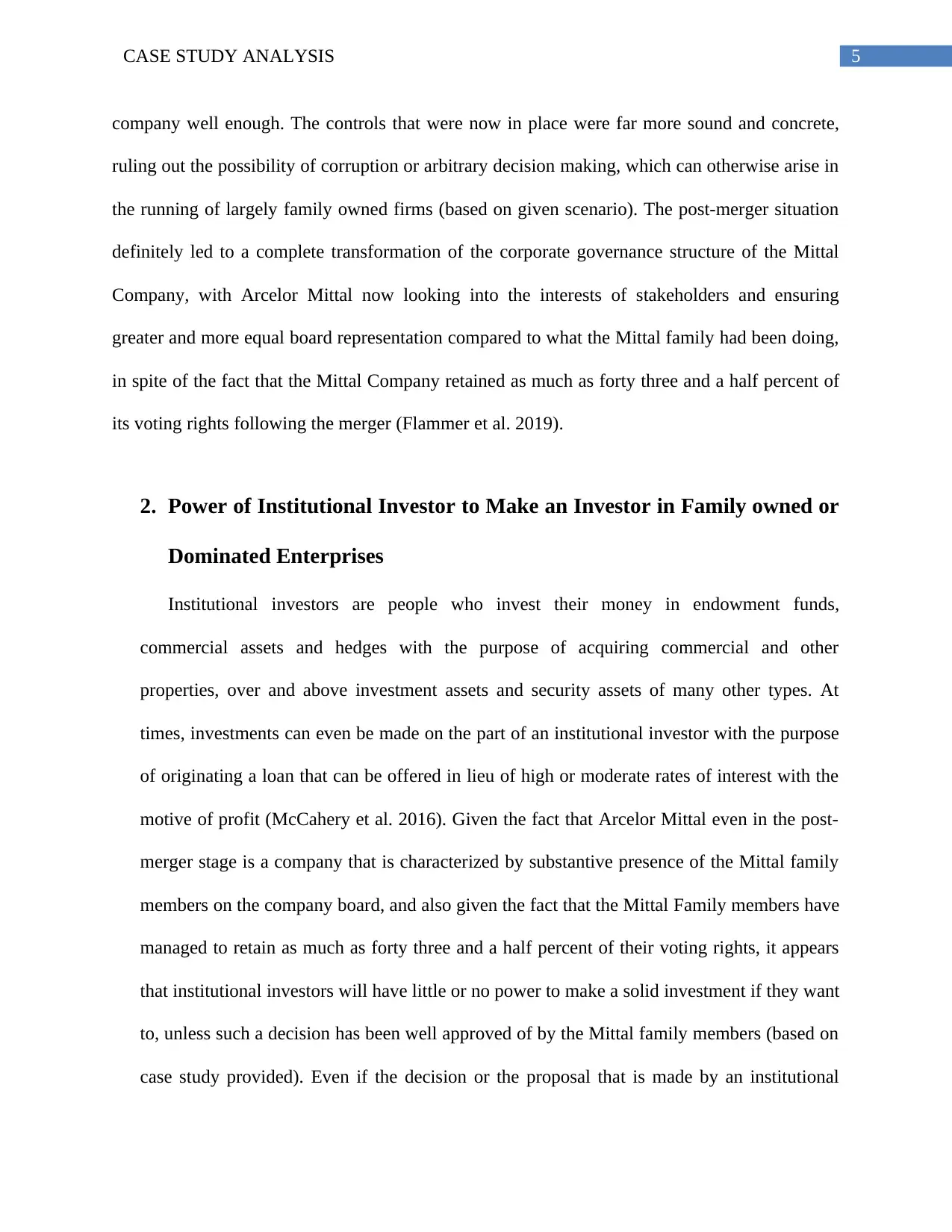
5CASE STUDY ANALYSIS
company well enough. The controls that were now in place were far more sound and concrete,
ruling out the possibility of corruption or arbitrary decision making, which can otherwise arise in
the running of largely family owned firms (based on given scenario). The post-merger situation
definitely led to a complete transformation of the corporate governance structure of the Mittal
Company, with Arcelor Mittal now looking into the interests of stakeholders and ensuring
greater and more equal board representation compared to what the Mittal family had been doing,
in spite of the fact that the Mittal Company retained as much as forty three and a half percent of
its voting rights following the merger (Flammer et al. 2019).
2. Power of Institutional Investor to Make an Investor in Family owned or
Dominated Enterprises
Institutional investors are people who invest their money in endowment funds,
commercial assets and hedges with the purpose of acquiring commercial and other
properties, over and above investment assets and security assets of many other types. At
times, investments can even be made on the part of an institutional investor with the purpose
of originating a loan that can be offered in lieu of high or moderate rates of interest with the
motive of profit (McCahery et al. 2016). Given the fact that Arcelor Mittal even in the post-
merger stage is a company that is characterized by substantive presence of the Mittal family
members on the company board, and also given the fact that the Mittal Family members have
managed to retain as much as forty three and a half percent of their voting rights, it appears
that institutional investors will have little or no power to make a solid investment if they want
to, unless such a decision has been well approved of by the Mittal family members (based on
case study provided). Even if the decision or the proposal that is made by an institutional
company well enough. The controls that were now in place were far more sound and concrete,
ruling out the possibility of corruption or arbitrary decision making, which can otherwise arise in
the running of largely family owned firms (based on given scenario). The post-merger situation
definitely led to a complete transformation of the corporate governance structure of the Mittal
Company, with Arcelor Mittal now looking into the interests of stakeholders and ensuring
greater and more equal board representation compared to what the Mittal family had been doing,
in spite of the fact that the Mittal Company retained as much as forty three and a half percent of
its voting rights following the merger (Flammer et al. 2019).
2. Power of Institutional Investor to Make an Investor in Family owned or
Dominated Enterprises
Institutional investors are people who invest their money in endowment funds,
commercial assets and hedges with the purpose of acquiring commercial and other
properties, over and above investment assets and security assets of many other types. At
times, investments can even be made on the part of an institutional investor with the purpose
of originating a loan that can be offered in lieu of high or moderate rates of interest with the
motive of profit (McCahery et al. 2016). Given the fact that Arcelor Mittal even in the post-
merger stage is a company that is characterized by substantive presence of the Mittal family
members on the company board, and also given the fact that the Mittal Family members have
managed to retain as much as forty three and a half percent of their voting rights, it appears
that institutional investors will have little or no power to make a solid investment if they want
to, unless such a decision has been well approved of by the Mittal family members (based on
case study provided). Even if the decision or the proposal that is made by an institutional
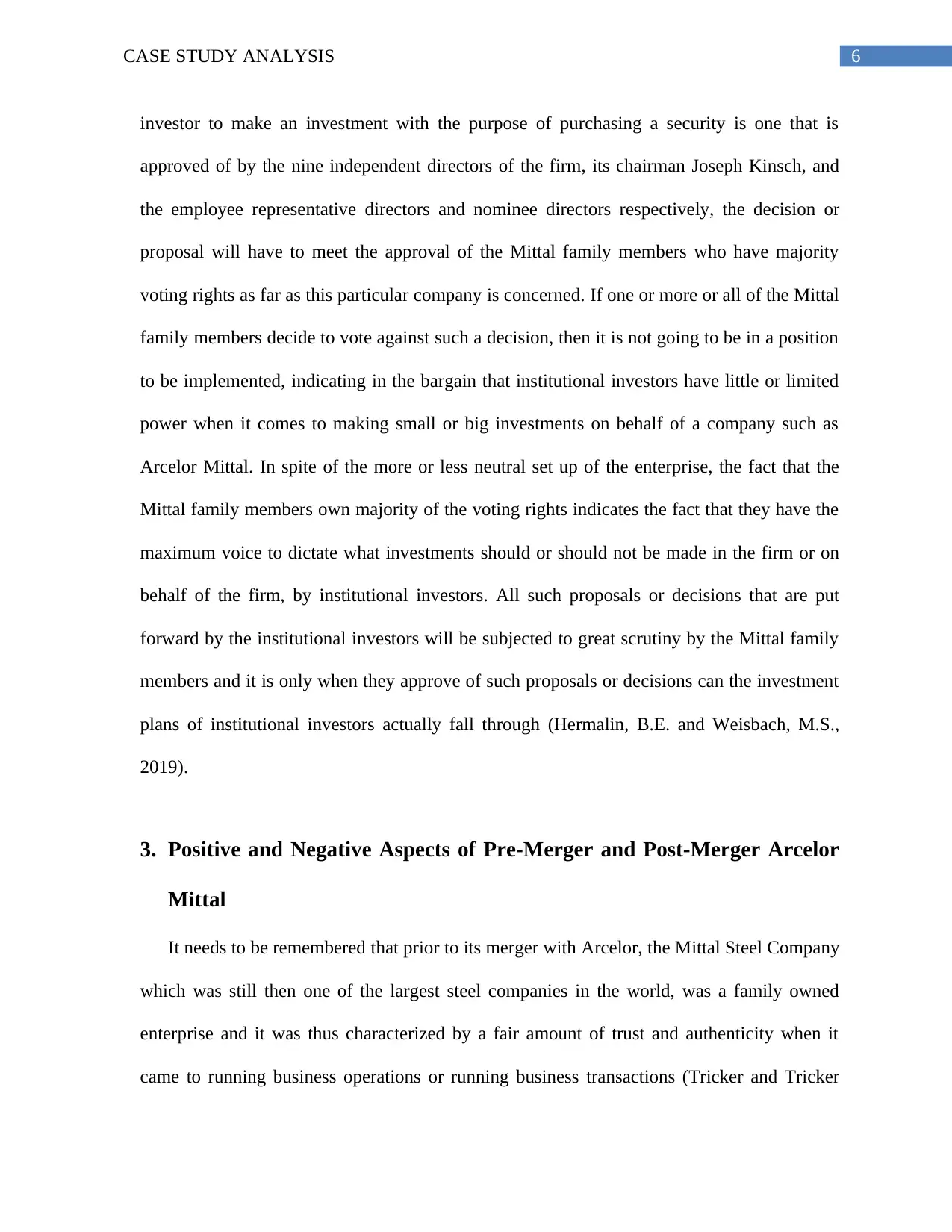
6CASE STUDY ANALYSIS
investor to make an investment with the purpose of purchasing a security is one that is
approved of by the nine independent directors of the firm, its chairman Joseph Kinsch, and
the employee representative directors and nominee directors respectively, the decision or
proposal will have to meet the approval of the Mittal family members who have majority
voting rights as far as this particular company is concerned. If one or more or all of the Mittal
family members decide to vote against such a decision, then it is not going to be in a position
to be implemented, indicating in the bargain that institutional investors have little or limited
power when it comes to making small or big investments on behalf of a company such as
Arcelor Mittal. In spite of the more or less neutral set up of the enterprise, the fact that the
Mittal family members own majority of the voting rights indicates the fact that they have the
maximum voice to dictate what investments should or should not be made in the firm or on
behalf of the firm, by institutional investors. All such proposals or decisions that are put
forward by the institutional investors will be subjected to great scrutiny by the Mittal family
members and it is only when they approve of such proposals or decisions can the investment
plans of institutional investors actually fall through (Hermalin, B.E. and Weisbach, M.S.,
2019).
3. Positive and Negative Aspects of Pre-Merger and Post-Merger Arcelor
Mittal
It needs to be remembered that prior to its merger with Arcelor, the Mittal Steel Company
which was still then one of the largest steel companies in the world, was a family owned
enterprise and it was thus characterized by a fair amount of trust and authenticity when it
came to running business operations or running business transactions (Tricker and Tricker
investor to make an investment with the purpose of purchasing a security is one that is
approved of by the nine independent directors of the firm, its chairman Joseph Kinsch, and
the employee representative directors and nominee directors respectively, the decision or
proposal will have to meet the approval of the Mittal family members who have majority
voting rights as far as this particular company is concerned. If one or more or all of the Mittal
family members decide to vote against such a decision, then it is not going to be in a position
to be implemented, indicating in the bargain that institutional investors have little or limited
power when it comes to making small or big investments on behalf of a company such as
Arcelor Mittal. In spite of the more or less neutral set up of the enterprise, the fact that the
Mittal family members own majority of the voting rights indicates the fact that they have the
maximum voice to dictate what investments should or should not be made in the firm or on
behalf of the firm, by institutional investors. All such proposals or decisions that are put
forward by the institutional investors will be subjected to great scrutiny by the Mittal family
members and it is only when they approve of such proposals or decisions can the investment
plans of institutional investors actually fall through (Hermalin, B.E. and Weisbach, M.S.,
2019).
3. Positive and Negative Aspects of Pre-Merger and Post-Merger Arcelor
Mittal
It needs to be remembered that prior to its merger with Arcelor, the Mittal Steel Company
which was still then one of the largest steel companies in the world, was a family owned
enterprise and it was thus characterized by a fair amount of trust and authenticity when it
came to running business operations or running business transactions (Tricker and Tricker
⊘ This is a preview!⊘
Do you want full access?
Subscribe today to unlock all pages.

Trusted by 1+ million students worldwide
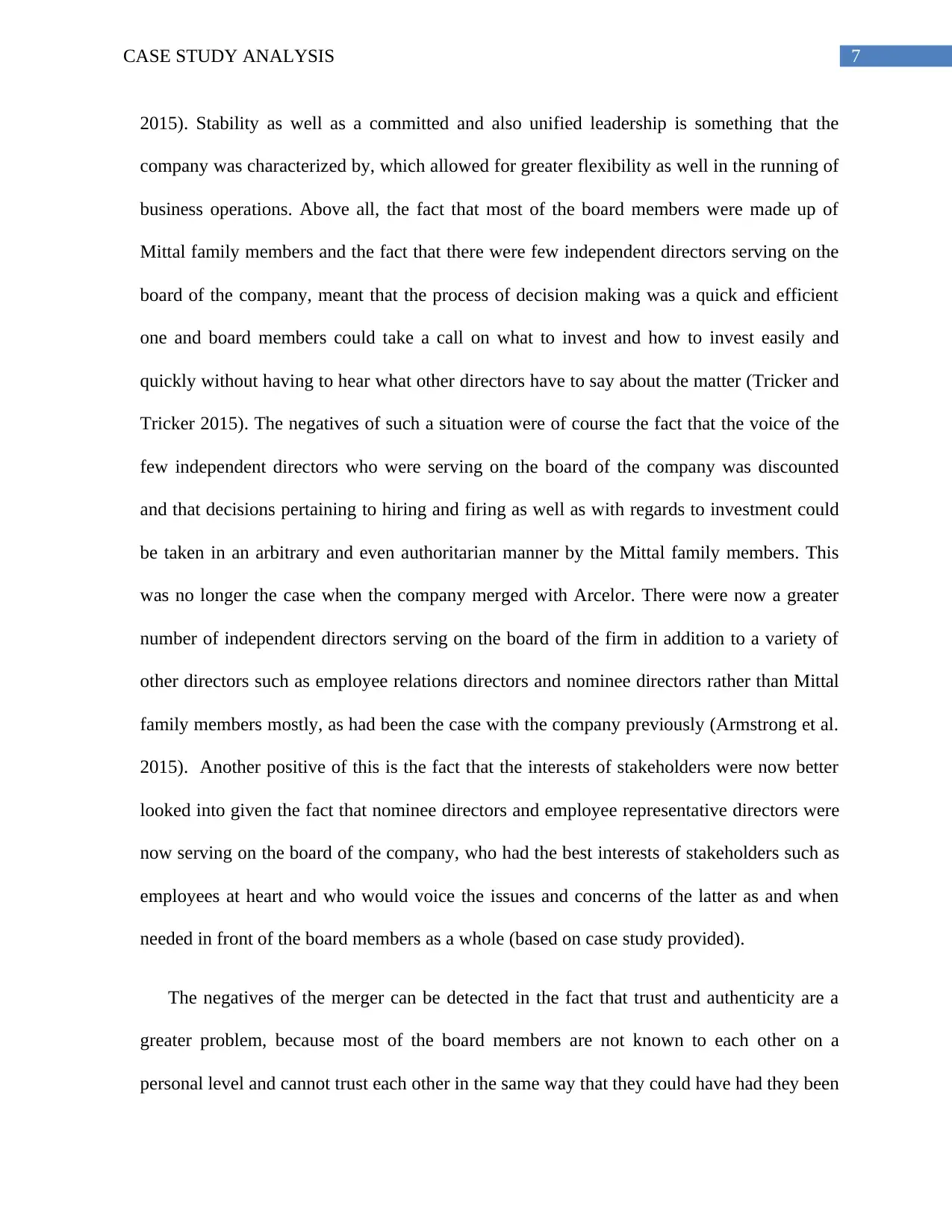
7CASE STUDY ANALYSIS
2015). Stability as well as a committed and also unified leadership is something that the
company was characterized by, which allowed for greater flexibility as well in the running of
business operations. Above all, the fact that most of the board members were made up of
Mittal family members and the fact that there were few independent directors serving on the
board of the company, meant that the process of decision making was a quick and efficient
one and board members could take a call on what to invest and how to invest easily and
quickly without having to hear what other directors have to say about the matter (Tricker and
Tricker 2015). The negatives of such a situation were of course the fact that the voice of the
few independent directors who were serving on the board of the company was discounted
and that decisions pertaining to hiring and firing as well as with regards to investment could
be taken in an arbitrary and even authoritarian manner by the Mittal family members. This
was no longer the case when the company merged with Arcelor. There were now a greater
number of independent directors serving on the board of the firm in addition to a variety of
other directors such as employee relations directors and nominee directors rather than Mittal
family members mostly, as had been the case with the company previously (Armstrong et al.
2015). Another positive of this is the fact that the interests of stakeholders were now better
looked into given the fact that nominee directors and employee representative directors were
now serving on the board of the company, who had the best interests of stakeholders such as
employees at heart and who would voice the issues and concerns of the latter as and when
needed in front of the board members as a whole (based on case study provided).
The negatives of the merger can be detected in the fact that trust and authenticity are a
greater problem, because most of the board members are not known to each other on a
personal level and cannot trust each other in the same way that they could have had they been
2015). Stability as well as a committed and also unified leadership is something that the
company was characterized by, which allowed for greater flexibility as well in the running of
business operations. Above all, the fact that most of the board members were made up of
Mittal family members and the fact that there were few independent directors serving on the
board of the company, meant that the process of decision making was a quick and efficient
one and board members could take a call on what to invest and how to invest easily and
quickly without having to hear what other directors have to say about the matter (Tricker and
Tricker 2015). The negatives of such a situation were of course the fact that the voice of the
few independent directors who were serving on the board of the company was discounted
and that decisions pertaining to hiring and firing as well as with regards to investment could
be taken in an arbitrary and even authoritarian manner by the Mittal family members. This
was no longer the case when the company merged with Arcelor. There were now a greater
number of independent directors serving on the board of the firm in addition to a variety of
other directors such as employee relations directors and nominee directors rather than Mittal
family members mostly, as had been the case with the company previously (Armstrong et al.
2015). Another positive of this is the fact that the interests of stakeholders were now better
looked into given the fact that nominee directors and employee representative directors were
now serving on the board of the company, who had the best interests of stakeholders such as
employees at heart and who would voice the issues and concerns of the latter as and when
needed in front of the board members as a whole (based on case study provided).
The negatives of the merger can be detected in the fact that trust and authenticity are a
greater problem, because most of the board members are not known to each other on a
personal level and cannot trust each other in the same way that they could have had they been
Paraphrase This Document
Need a fresh take? Get an instant paraphrase of this document with our AI Paraphraser
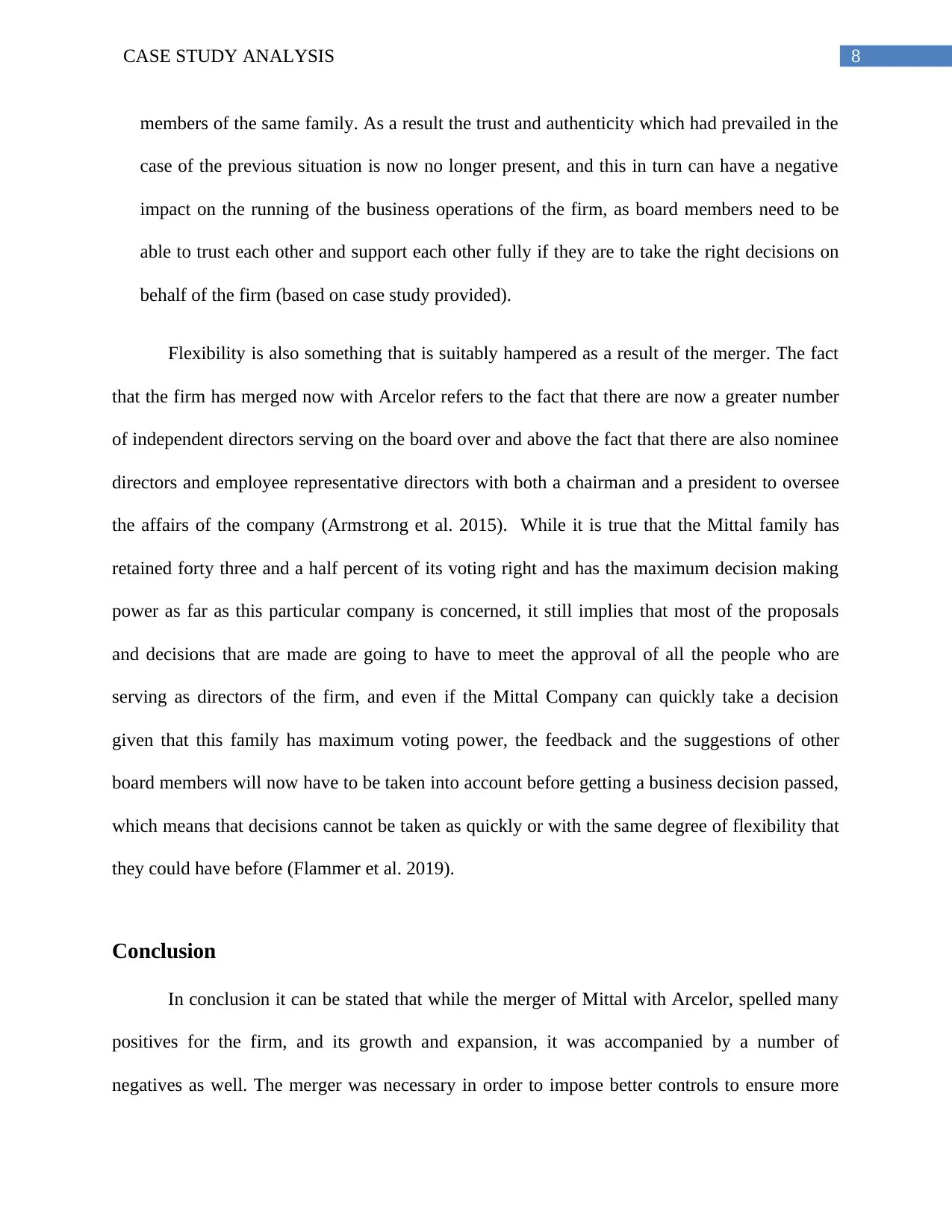
8CASE STUDY ANALYSIS
members of the same family. As a result the trust and authenticity which had prevailed in the
case of the previous situation is now no longer present, and this in turn can have a negative
impact on the running of the business operations of the firm, as board members need to be
able to trust each other and support each other fully if they are to take the right decisions on
behalf of the firm (based on case study provided).
Flexibility is also something that is suitably hampered as a result of the merger. The fact
that the firm has merged now with Arcelor refers to the fact that there are now a greater number
of independent directors serving on the board over and above the fact that there are also nominee
directors and employee representative directors with both a chairman and a president to oversee
the affairs of the company (Armstrong et al. 2015). While it is true that the Mittal family has
retained forty three and a half percent of its voting right and has the maximum decision making
power as far as this particular company is concerned, it still implies that most of the proposals
and decisions that are made are going to have to meet the approval of all the people who are
serving as directors of the firm, and even if the Mittal Company can quickly take a decision
given that this family has maximum voting power, the feedback and the suggestions of other
board members will now have to be taken into account before getting a business decision passed,
which means that decisions cannot be taken as quickly or with the same degree of flexibility that
they could have before (Flammer et al. 2019).
Conclusion
In conclusion it can be stated that while the merger of Mittal with Arcelor, spelled many
positives for the firm, and its growth and expansion, it was accompanied by a number of
negatives as well. The merger was necessary in order to impose better controls to ensure more
members of the same family. As a result the trust and authenticity which had prevailed in the
case of the previous situation is now no longer present, and this in turn can have a negative
impact on the running of the business operations of the firm, as board members need to be
able to trust each other and support each other fully if they are to take the right decisions on
behalf of the firm (based on case study provided).
Flexibility is also something that is suitably hampered as a result of the merger. The fact
that the firm has merged now with Arcelor refers to the fact that there are now a greater number
of independent directors serving on the board over and above the fact that there are also nominee
directors and employee representative directors with both a chairman and a president to oversee
the affairs of the company (Armstrong et al. 2015). While it is true that the Mittal family has
retained forty three and a half percent of its voting right and has the maximum decision making
power as far as this particular company is concerned, it still implies that most of the proposals
and decisions that are made are going to have to meet the approval of all the people who are
serving as directors of the firm, and even if the Mittal Company can quickly take a decision
given that this family has maximum voting power, the feedback and the suggestions of other
board members will now have to be taken into account before getting a business decision passed,
which means that decisions cannot be taken as quickly or with the same degree of flexibility that
they could have before (Flammer et al. 2019).
Conclusion
In conclusion it can be stated that while the merger of Mittal with Arcelor, spelled many
positives for the firm, and its growth and expansion, it was accompanied by a number of
negatives as well. The merger was necessary in order to impose better controls to ensure more
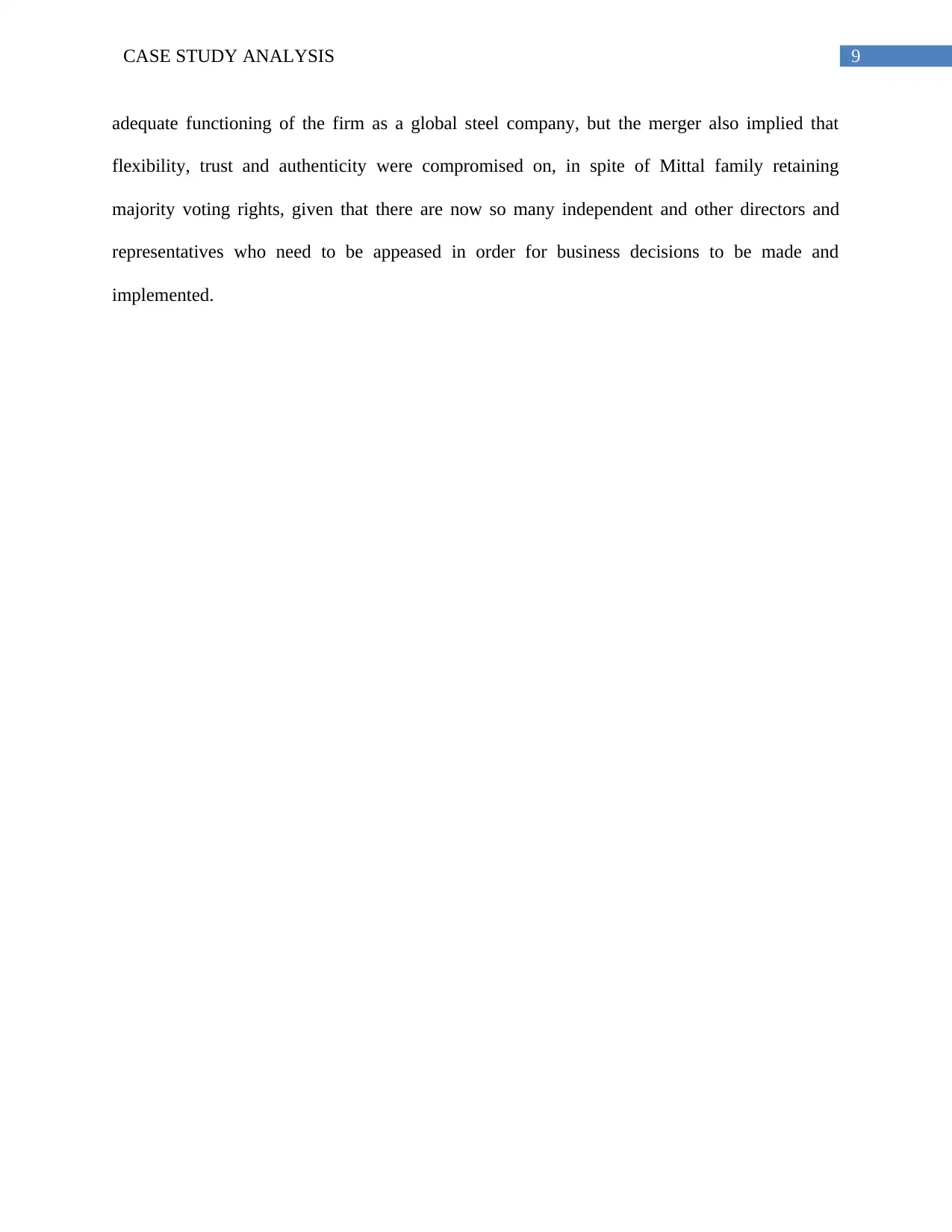
9CASE STUDY ANALYSIS
adequate functioning of the firm as a global steel company, but the merger also implied that
flexibility, trust and authenticity were compromised on, in spite of Mittal family retaining
majority voting rights, given that there are now so many independent and other directors and
representatives who need to be appeased in order for business decisions to be made and
implemented.
adequate functioning of the firm as a global steel company, but the merger also implied that
flexibility, trust and authenticity were compromised on, in spite of Mittal family retaining
majority voting rights, given that there are now so many independent and other directors and
representatives who need to be appeased in order for business decisions to be made and
implemented.
⊘ This is a preview!⊘
Do you want full access?
Subscribe today to unlock all pages.

Trusted by 1+ million students worldwide
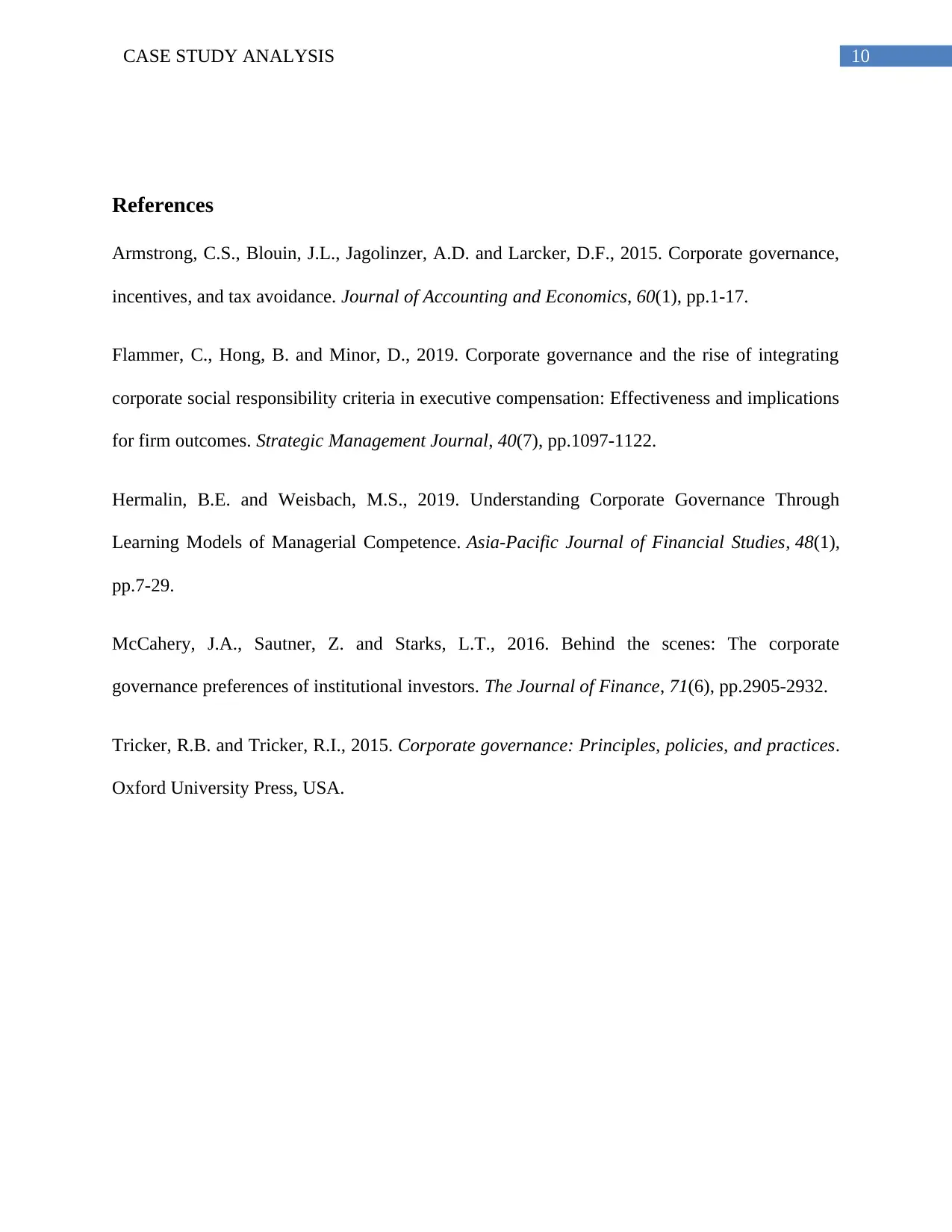
10CASE STUDY ANALYSIS
References
Armstrong, C.S., Blouin, J.L., Jagolinzer, A.D. and Larcker, D.F., 2015. Corporate governance,
incentives, and tax avoidance. Journal of Accounting and Economics, 60(1), pp.1-17.
Flammer, C., Hong, B. and Minor, D., 2019. Corporate governance and the rise of integrating
corporate social responsibility criteria in executive compensation: Effectiveness and implications
for firm outcomes. Strategic Management Journal, 40(7), pp.1097-1122.
Hermalin, B.E. and Weisbach, M.S., 2019. Understanding Corporate Governance Through
Learning Models of Managerial Competence. Asia‐Pacific Journal of Financial Studies, 48(1),
pp.7-29.
McCahery, J.A., Sautner, Z. and Starks, L.T., 2016. Behind the scenes: The corporate
governance preferences of institutional investors. The Journal of Finance, 71(6), pp.2905-2932.
Tricker, R.B. and Tricker, R.I., 2015. Corporate governance: Principles, policies, and practices.
Oxford University Press, USA.
References
Armstrong, C.S., Blouin, J.L., Jagolinzer, A.D. and Larcker, D.F., 2015. Corporate governance,
incentives, and tax avoidance. Journal of Accounting and Economics, 60(1), pp.1-17.
Flammer, C., Hong, B. and Minor, D., 2019. Corporate governance and the rise of integrating
corporate social responsibility criteria in executive compensation: Effectiveness and implications
for firm outcomes. Strategic Management Journal, 40(7), pp.1097-1122.
Hermalin, B.E. and Weisbach, M.S., 2019. Understanding Corporate Governance Through
Learning Models of Managerial Competence. Asia‐Pacific Journal of Financial Studies, 48(1),
pp.7-29.
McCahery, J.A., Sautner, Z. and Starks, L.T., 2016. Behind the scenes: The corporate
governance preferences of institutional investors. The Journal of Finance, 71(6), pp.2905-2932.
Tricker, R.B. and Tricker, R.I., 2015. Corporate governance: Principles, policies, and practices.
Oxford University Press, USA.
1 out of 10
Related Documents
Your All-in-One AI-Powered Toolkit for Academic Success.
+13062052269
info@desklib.com
Available 24*7 on WhatsApp / Email
![[object Object]](/_next/static/media/star-bottom.7253800d.svg)
Unlock your academic potential
Copyright © 2020–2025 A2Z Services. All Rights Reserved. Developed and managed by ZUCOL.



